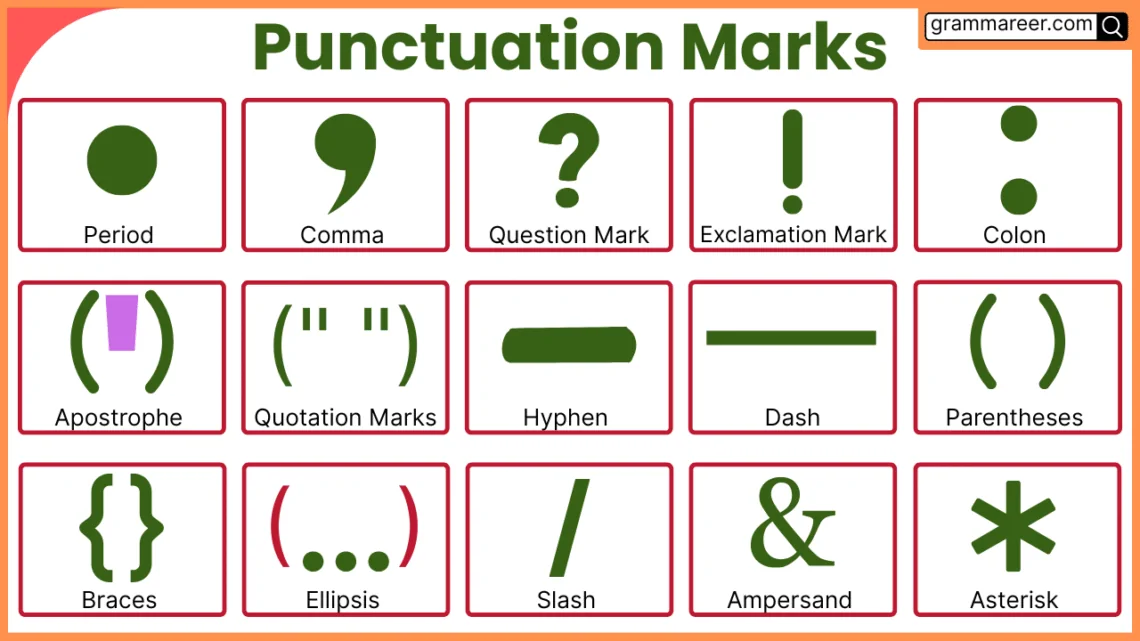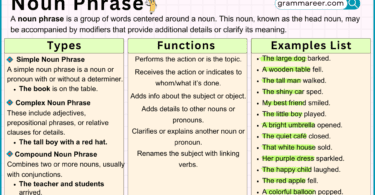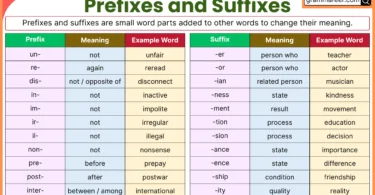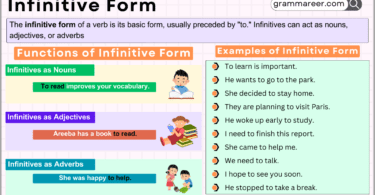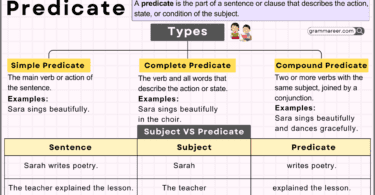Punctuation marks in English are symbols like commas, periods, and question marks that help organize sentences and show meaning clearly. Without punctuation, writing can become confusing or hard to understand. In this post, English learners will find simple explanations and example sentences for each punctuation mark to improve their composition. These examples show how punctuation works in real English sentences, making it easier to use correctly in writing.
Table of Contents
What Are Punctuation Marks?
Punctuation marks are signs we use in writing to make our sentences clear and easy to understand. They show us where to pause, stop, ask a question, express excitement, or separate ideas. They help the reader know when There are different types of punctuation marks, and each one has its own function.
Why Are Punctuation Marks Important in English Grammar?
Punctuation marks are important because they help us understand the meaning of sentences clearly. They show us when to pause, stop, ask a question, or show feelings. Without punctuation, writing becomes confusing and hard to read. Just like traffic signs help drivers, punctuation helps readers know how to read correctly. For example:
- “Let’s eat, Grandma!” (means we are calling Grandma to eat)
- “Let’s eat Grandma!” (means we are eating Grandma – which is wrong!)
This shows how punctuation can change the whole meaning of a sentence. That’s why every English learner should learn punctuation to write and speak clearly.
List of All Punctuation Marks in English
Here is a complete list of all commonly used punctuation marks in English grammar along with their names:
- Full Stop / Period
. - Comma
, - Question Mark
? - Exclamation Mark
! - Colon
: - Semicolon
; - Hyphen
- - Dash / Em Dash
— - Apostrophe
' - Quotation Marks / Inverted Commas
" " - Parentheses / Round Brackets
( ) - Square Brackets / Brackets
[ ] - Braces / Curly Brackets
{ } - Ellipsis
… - Slash / Forward Slash
/ - Backslash
\\ - Interrobang
‽ - Prime (used in measurements like feet or minutes)
′ - Double Prime (used in measurements like inches or seconds)
″ - Non-breaking Hyphen
‐ - Figure Dash
‑ - Middle Dot
·

14 Punctuation Marks with Examples
Below is a detailed explanation of each common punctuation mark, written in simple English with helpful examples.
1. Full Stop (.)
A full stop is used at the end of a complete sentence. It tells the reader that the sentence or idea is finished. We use it in statements, facts, or commands that are not questions or exclamations. For Example
- I like to watch movies.
- She is a good doctor.
- They are playing in the garden.
2. Comma (,)
A comma is used to separate words or groups of words in a sentence. It helps to avoid confusion, especially when listing things, adding extra information, or connecting two ideas with conjunctions. For Example
- I bought apples, oranges, and mangoes.
- After the show, we went out for dinner.
- He is smart, but he sometimes forgets things.
3. Question Mark (?)
A question mark is used at the end of a sentence to show that it is a question. It replaces the full stop in such cases and helps the reader know a response is expected. For Example
- Where are you going?
- Did you complete your homework?
- What time is the meeting?
4. Exclamation Mark (!)
An exclamation mark is used to show strong feelings like excitement, anger, surprise, or happiness. It adds emotion to the sentence and is placed at the end. For Example
- Wow! That’s a beautiful painting!
- Stop! You’re going the wrong way!
- Congratulations! You won the game!
5. Apostrophe (’)
An apostrophe is used to show that something belongs to someone (possession) or to form contractions (shortened forms of words by removing letters). For Example
- This is Maria’s dress.
- I can’t go with you.
- He doesn’t like spicy food.
6. Quotation Marks (” “)
Quotation marks are used to show the exact words someone has said or written. They are also used for titles of short stories, songs, or articles. For Example
- She said, “I am learning English.”
- “Please sit down,” the teacher said.
- I read the story “The Honest Woodcutter.”
7. Colon (:)
A colon is used to introduce a list, an explanation, or something important. It usually comes after a complete sentence and points to what follows next. For Example
- He brought everything: a pen, a notebook, and a ruler.
- She had one dream: to become a pilot.
- There is one rule: be kind to others.
8. Semicolon (;)
A semicolon connects two related sentences that could stand alone but are closely connected. It can also be used to separate items in a list when those items have commas. For Example
- I went to the market; it was very crowded.
- They visited London, England; Paris, France; and Berlin, Germany.
- She loves reading; he prefers writing.
9. Hyphen (-)
A hyphen joins two or more words to form compound words. It is also used when splitting a word at the end of a line in handwriting or printing. For Example
- She is a well-known artist.
- My brother-in-law is very helpful.
- It’s a long-term plan.
10. Parentheses ( )
Parentheses are used to include extra information in a sentence. The information inside the brackets is not the main point, but it helps clarify or add detail. For Example
- My uncle (who is 60 years old) still plays cricket.
- They visited Murree (a hill station in Pakistan).
- She finally arrived (after two hours).
11. Ellipsis (…)
An ellipsis is used when part of a sentence is missing or when the speaker is pausing, hesitating, or thinking. It creates a dramatic effect or leaves something to the imagination. For Example
- I’m not sure… maybe we should wait.
- She said, “I was going to tell you…”
- I can’t believe it… he’s really gone.
12. Slash (/)
A slash is used to show alternatives or choices. It can also separate parts of web addresses, dates, or lines of poetry. For Example
- Please press the yes/no button.
- Bring your notebook and pen/pencil.
- His birthday is 10/05/2025.
13. Brackets [ ]
Brackets are used to add extra or clarifying information, especially inside quotes or explanations. For example
- She said, “He [the teacher] was very kind.”
- The report states that the team won “[despite injuries] and poor weather.”
- Please include your full name [first and last] on the form.
14. Dash (—)
A dash shows a break in thought, adds emphasis, or introduces extra information in a sentence. For example
- I was thinking — maybe we should leave early.
- He brought everything — snacks, drinks, and games.
- She’s not just smart — she’s brilliant!
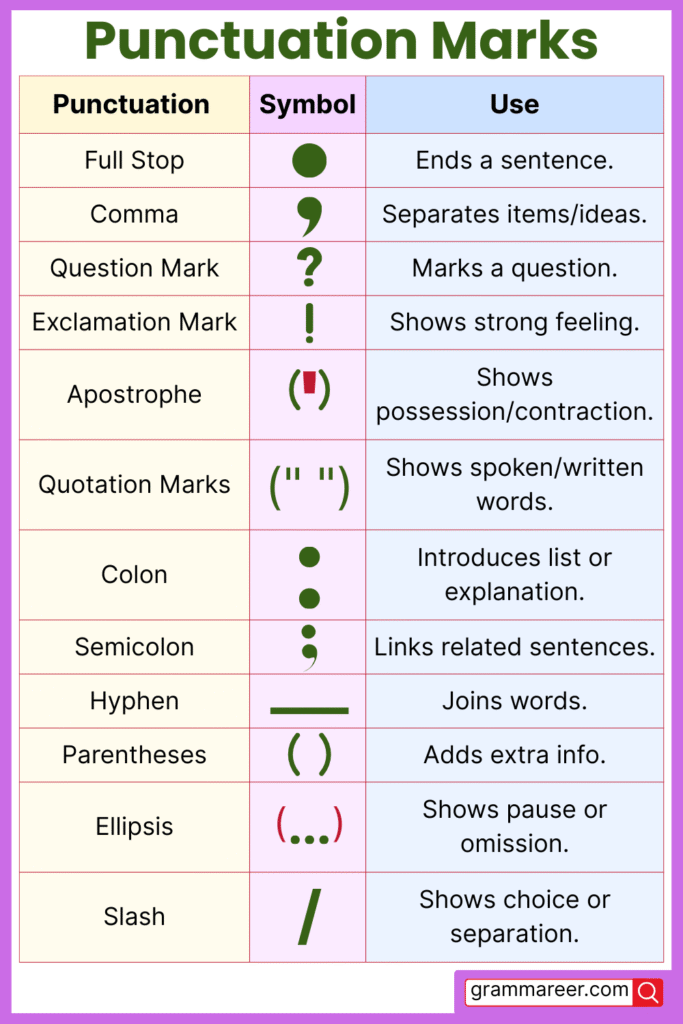
Common Punctuation Mistakes English Learners Should Avoid
Many English learners make small punctuation mistakes that can change the meaning of a sentence. Here are some common errors to watch out for:
- Missing Full Stop (.) at the End of Sentences
✅ Correct: I like to read books.
❌ Wrong: I like to read books - Using Comma Instead of Full Stop
✅ Correct: She is my friend. She lives in London.
❌ Wrong: She is my friend, She lives in London. - Wrong Use of Apostrophe (’)
✅ Correct: It’s raining today. (It is)
❌ Wrong: Its raining today.
✅ Correct: The dog’s tail is short. (Possession)
❌ Wrong: The dogs tail is short. - No Question Mark (?) for Questions
✅ Correct: What is your name?
❌ Wrong: What is your name - Unnecessary Spaces Before Punctuation
✅ Correct: I am happy, and I want to dance.
❌ Wrong: I am happy , and I want to dance . - Using Too Many Exclamation Marks (!)
✅ Correct: Wow! That’s amazing!
❌ Wrong: Wow!!!! That’s amazing!!! - Incorrect Capitalization After Punctuation
✅ Correct: I am tired. She is too.
❌ Wrong: I am tired. she is too.
FAQs about Punctuation Marks
There are 14 main punctuation marks in English: period, comma, question mark, exclamation mark, colon, semicolon, apostrophe, quotation marks, hyphen, dash, parentheses, brackets, ellipsis, and slash.
Punctuation marks help clarify the meaning of sentences. They show where to pause, where a sentence ends, and how ideas are connected. Without them, writing becomes confusing.
A colon (:) introduces lists or explanations. A semicolon (;) joins two related sentences or separates complex items in a list.
Yes! Sentences can have multiple punctuation marks like commas, quotation marks, and a full stop or question mark at the end.
Conclusion
Punctuation marks may look small, but they play a big role in writing good English. They help us understand sentences clearly and avoid confusion. Start by learning and practicing one mark at a time. With regular practice, you’ll become better and more confident in your writing.
You May Also Like

